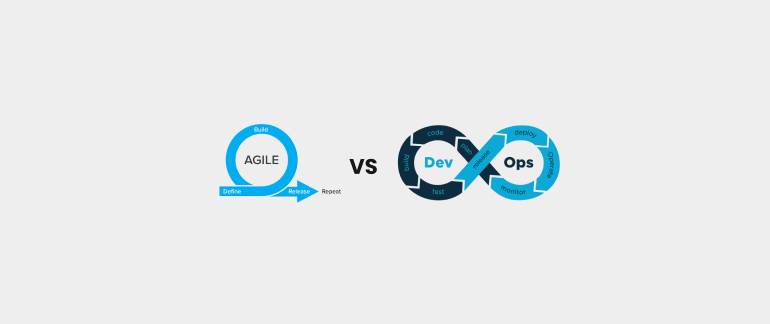The demand for Agile Development and Tests Services Market size and share is expected to rise by 10 billion dollars, from $20 Billion in 2020 to $30 Billion by 2026, at a compound annual growth rate (CAGR) of 18% during the forecast period 2021-2026. The DevOps market share surpassed $7 billion in 2021 and is expected to hit $30 billion by 2028 at a compound annual growth rate of over 20% for the period 2022-2028.
When integrated efficiently, DevOps and Agile complement each other and can significantly improvement software development and delivery processes within companies. Let’s dig deeper into the synergy between the two and find answers to ‘how do Agile and DevOps interrelate?’
The State of Agile and DevOps
Although diverse terms, Agile methodology and DevOps are in a state to complement one another to make sure that the quality assurance (QA) industry remains strong. Both techniques also ensure that the software products cater to the demands of the market. When efficiently combined, these approaches can ensure zero software downtime or discrepancies and a faster SDLC.
Furthermore, these two techniques facilitate the management of software inconsistencies and outages for tech teams and DevOps. The following questions arise:
- Is DevOps a subset of Agile?
- Can they complete each other?
- Are these two approaches exclusive?
Let us understand these points and make a correct conclusion – Agile and DevOps, how do they interrelate?
What Is Agile?

The Agile methodology has a broad history of usage in software development, but its recent rise to prominence is attributed to the DevOps movement.
The term “agile” essentially means a collection of approaches built on the principles of evolutionary and rapid development. For that, it is essential to first find out the requirements of your business and then devise goods/services to meet those requirements.
This type of development is mostly called evolutionary development and is meant to be a process that happens in an ongoing fashion. This signifies that you must tweak your processes in the right manner to adapt to the changes occurring in your business.
Compared to more traditional methods of development, such as waterfall, evolutionary development presents a series of unique advantages.
Popular Agile Technologies Used
Any Agile team will include multiple product development responsibilities and roles that support a project’s complete direction. The product owner signifies the stakeholders and upholds the extended project vision. Business executives, investors, and clients will help to address issues within the development life-cycle to support that assignment.
Service providers go with Agile development tools due to the high level of coordination needed for complicated projects with simultaneous work necessities. Most technologies fit within popular project management frameworks such as Scrum or Kanban.
Key Agile tools include:
- GitHub: The code hosting platform
- JIRA: Work management and issue-tracking software
- Planbox: A sophisticated modular platform to check lifecycle competency
- Active Collab: Project management results along with digital communication apps
Agile testing challenges:
- Performance Bottlenecks
- Early Defect Detection
- Inadequate Test Coverage
- QA Wait Time
- Changing Requirements
- Slower Feedback Loop
- Different Browsers/Devices (Device Fragmentation)
- Skipping or Deferring Essential Tests
- QA Tester’s Accessibility
What Is DevOps?

DevOps refers to a transformation intended to integrate the operation and software development teams from a business perspective.
- It is a mix of techniques found in Agile and Lean methodologies, and it is used for transforming the way organizations produce software products.
- DevOps combines the disciplines of development with operations to make a more efficient process that addresses the challenges businesses face today.
- It is essentially an umbrella term that explains a set of processes that aim to bridge the gap between software development and IT operations.
This is the first point to understand how Agile and DevOps interrelate. In a conventional approach, there are several handoffs between different responsibilities in an organization. When understanding how Agile and DevOps can work together, we may visualize a world without hurdles or handoffs. This will instantly produce savings during the life cycle of the products.
Agile teams are unique when compared to a more conventional organizational structure. An Agile team consistently reviews its development processes for improvement. This allows for meaningful growth and promotes a model focused on constant integration and seamless delivery.
Popular DevOps Technologies Used
DevOps methodology mostly favors cross-functional teams with definite roles that manage every single aspect of a product build. The accurate technology allows teams to tap the benefits of the DevOps methodology. DevOps tools can help with implementation and service providers proffer tools that support the automation and collaboration of the DevOps product lifecycle:
- JIRA: Tracking software for bugs/errors
- Jenkins: Automated tools to assist constant integration
- Maven: Automated tools to handle Java projects
- Git: Software tools for tracking source code modifications
- Bitbucket: Source code repository for CD/CI optimisation
How do Agile and DevOps Interrelate?
One common myth is that Agile and DevOps cannot work together. This point affects everyone involved in the software development and delivery field. Both these techniques can essentially add to the pillars of adaption, transparency, and inspection to allow product teams to arrange, deliver, and uphold intricate products.
Both Agile and DevOps demonstrate powerful ideas that add value to the workflow of a team. The combination testifies to the venture’s success.
- Although Agile and DevOps differ in their approach, they have similar goals, such as effective software development and speedy product releases.
- DevOps can fit within each stage of a product’s lifecycle, setting upon the manageable jobs outlined by Agile.
- Agile depends on company values, while DevOps depends on workflow over the delivery pipeline. The two approaches enrich development collectively.
Let’s find out about Agile and DevOps and how do they interrelate.
1. Automation Testing
Both Agile and DevOps test, although in complementary ways. Agile employs particular skills from individuals to form standards that guarantee the quality of the product. On the flip side, DevOps automates recurring testing and builds in compliance with product deployments. As a result, high-end testing becomes possible as all individuals shoulder the quality assurance (QA) duty.
2. Continuous Integration
Both Agile and DevOps rely on continuous integration (CI) and continuous delivery (CD) to enhance the product delivery lifecycle. While Agile capitalizes on small portions of work to integrate into a cohesive whole, DevOps automates code integrations that accelerate release deployments as required. Collectively, they ensure a reliable, effective, and safe pipeline.
3. Modular Design
Agile uses design principles that are modular and reusable, creating environments that promote experimentation and research. Similarly, modular components like Git repositories or containers help in executing Agile principles at large.
4. Development Flow
Both techniques support management. While Agile sets the phase for learning, skills development, and team input, DevOps automates each operational task to streamline collaboration and responsibility amongst dev teams. Together, the goals of the team get accomplished with an ideal project and relevant management flow.
5. Feedback Cycles
Both Agile and DevOps stress on adaptability and flexibility. Agile employs sprints and Scrum as management procedures, comprising fast feedback from all those concerned. DevOps, on the other hand, supports such responses by automating and flagging failures. Together, the product quality improves as per user expectations.
The Interaction Between Agile And DevOps Principles
Many businesses and technology learners assume that Agile and DevOps are two different methods. That is correct, but both methodologies are about swift, continuous improvement in software development and related products. While there are some differences, both approaches focus on getting the best out of their teams.
So, a question pops up – How do Agile and DevOps interrelate?
Both Agile and DevOps are about collusion between teams, and both aim at creating high-quality, dependable software. Yet clearly, there are differences between the two. Let us look at some commonalities between the two approaches.
- They work best when they are integrated. The objective of an integrated method is to produce high-quality and reliable software as fast as possible.
Through the cooperation and alliance between developers, operations staff, testers, and other team members, you can attain a quicker turnaround time for your software. To make this collaboration successful, teams should follow certain principles such as consistency, agility, and communication.
- In addition to this, an integrated Agile and DevOps approach can help to minimize the risk of software defects. For that, you should work with your team to make automated tests for your software.
- By integrating Agile and DevOps development processes, it is possible to increase the overall quality of your team. You can identify problems through testing before they get to customers. Also, operations can be integrated into the process, increasing the software release speed and minimizing bottlenecks.
- These principles are not unalterable rules. On the contrary, they are guidelines to implement good practices to develop software and deliver it more effectively. They do not replace conventional methods of IT operations or doing business. Instead, they complement one another to attain greater results as swiftly as possible.
| Prepare these top DevOps interview questions and answers to crack your tech interview in your first try! |
Key Takeaways
Agile and DevOps are distinct in many ways. They came into existence due to an alteration in software development patterns. However, both approaches aim at developing software without customer dissatisfaction and downtime. Now, a lack of knowledge leaves organizations wondering how do Agile and DevOps interrelate? The answer to the question is that both methodologies go hand in hand, and their interrelation leads to high business growth and satisfied users.
Explore more about our DevOps Master Program and Advanced Cloud Native DevOps Master Program and learn from live interactive sessions from our experts.
Amol Shete
Senior Software Engineer
A well-experienced DevOps engineer who loves to discuss cloud, DevOps, and Kubernetes. An energetic team player with great communication & interpersonal skills.
FAQ's
Yes, Agile teams can adopt DevOps practices to improve their ability to deliver high-quality software efficiently and effectively.
Agile and DevOps are two complementary approaches to software development and delivery that focus on different aspects of the development lifecycle
Agile and DevOps are two distinct but interconnected approaches. They vary based on their focus and purpose, team structures and their scope.





